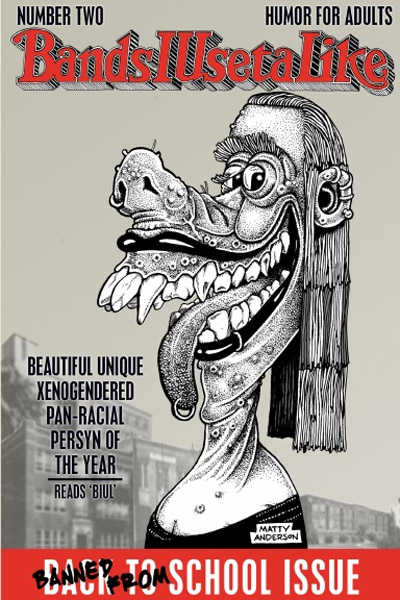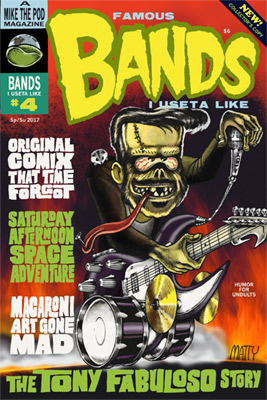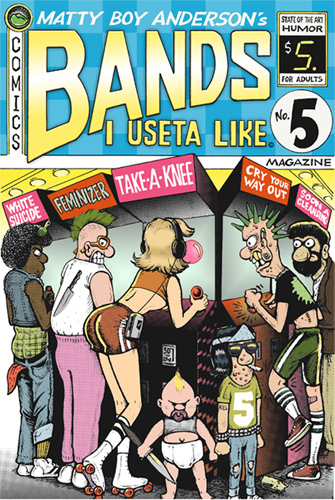Hey, you know when depicting any female consort in a comic strip is a good idea? Never. You know who wants to read comics about you and your spouse (if you have one), past or present? No one. Other than yourself, do you know who thinks comics about your relationships are funny? Nobody. (Now, putting buddies in strips? Gold. Who doesn’t love that?)
As if it weren’t patently obvious, this is one of the earliest strips. That lettering is a style I developed for the fourth issue of Mike The Pod Comix, where BIUL first bowed. Sometime later I reverted fully to the Groening G, which I prefer to the less-squiggly version here. Earlier in the ’90s, I used an adapted Groening G in Lemmings and Drop Dead, hence I was trying to break from it by 1998. So much for that.
Something else no one notices; I had a more “Jughead” type shnoz in the early strips. My nose evolved over the years into a sharp 45° angle. I draw myself with a prominent proboscis not because I have a huge honker in reality, but because
- Despite having been in a half-dozen fistfights, give or take, my nose has never been broken. I’m like Vanity Smurf, so I protect it instinctively, and on average, attackers tend to sock me in the teeth, anyhow.
- My sense of smell is excruciatingly acute. Remember the envelope-sniffers from Hannibal? Mine is better. I can smell lies.
How’s this for something less narcissistic and dull? Let’s talk about COCAINE!!!
(Cocaine is still pretty narcissistic, but let’s get this ox moving already.)
Cocaine was quasi-legal for a chunk of the 20th century. In my view, it can be fun for a night with a gaggle of girls. But with regular use, it drains chemicals your brain can’t afford to spare, and gives you the personality of shattered glass. Before long, you can’t walk the tightrope anymore, and you’re done for. Everyone who rides the white pony, falls.
Now, I’m not going to launch into another tirade about reaping the whirlwind, but it’s a poorly-kept secret that cocaine was an ingredient in a substantial portion of classic jazz.
Here’s why it’s more or less still secret; in the early 1900s, the U.S. Government openly demonized both black people and jazz musicians as degenerate drug abusers. It does no good to surmise that this person might have been on coke, this person might have been on heroin, etc.; those are issues personal to the artists, and not part of the recorded work (unless they actually are). It’s an insult to any artist to imply that their talents are the result of a drug.
So, I’m not implying that Oingo Boingo was a better band when they were on cocaine. I’m not implying that any band member ever touched cocaine.
All I’m saying is… Oingo Boingo’s discography and sound remind me of someone who used cocaine. That’s all. Got it?
Coke has been used by countless entertainers who need to sustain a manic energy. Gyms weren’t a part of American life until the 1980s, and we take for granted nowadays how much we know about our health. Entertainers rarely took care of themselves until fairly lately; it was all full speed ahead, pay the piper tomorrow. The competition is fierce, and you’ve got to keep up. Kinda like The Gong Show.
https://youtu.be/6SX8cWGcHJs
I was a hardcore Boingo fanatic for years, and I have no clue who the girl with the accordion and the spectacular legs is. I don’t want to go into the lineup here, because this was a big band with a lot of people. But in the early going, they were known as the Mystic Knights of the Oingo Boingo, and they sounded like what happens when you eat a lot of Halloween candy. They made a movie (Forbidden Zone), which I’ve had a relationship with since 1990, so I have to extrapolate in a separate article on that. In any case, when they started out they sounded like this.
If you listen closely, you’ll hear the lyric “sniffing cocoa”, but again- I am not implying that there are drugs being used. They cemented their status as “new wave” over their first two albums, Only A Lad and Nothing To Fear. The first has an incredible painting of a Boy Scout, with several hidden images, and the second is by Georganne Deen. Everything Georganne Deen has done is great. She is a great artist, and I’m devoting more than one sentence to her so you remember her name: Georganne Deen.
Nothing To Fear has a song called “Grey Matter” that I was so obsessed with in 10th grade, I started listening to it played backwards. Now, I have to admit the best track on the album is the last:
https://youtu.be/f9MeCl0vC5c
The buzz is starting to wear off, though. Good For Your Soul, the third album, is the last stop before things get really earthbound. The songs are all solid, and there’s a creepy vibe connecting the tracks that skipped the last album. Still, in my opinion, again the last track is the best.
That’s prime ’80s beef right there. You can hear compositional elements that frontman Danny Elfman would later beat into the ground on the soundtracks to Darkman and Scrooged. Elfman did some of his greatest work long before he hit it huge, for instance the love theme from Forbidden Zone:
Highlights of Elfman’s film score résumé include Pee-Wee’s Big Adventure, Midnight Run, Back To School (which features a love theme on par with his Forbidden Zone work), Dick Tracy, and the title themes from Batman and Nightbreed. The guy is a hardworking composer who wrote the theme to the longest-running prime time show in history; I don’t begrudge him a few retraced steps.
With the fourth Boingo album, the focus of their image shifted wholly to Elfman, ostensibly to cushion the blow of an extreme change in sound. I don’t think anyone argues that this change played to their strengths. This was all moot, because the success of combining Oingo Boingo with ’80s teen movies eclipsed anything they’d done before.
“Dead Man’s Party” is admittedly a good song, but the other tracks on its titular album all have the same texture; block-heavy percussion, weirdly-affected vocals, and deep call-and-response choruses. At this point it’s really over with for good Boingo. Sorry, you know it’s true.
1987 brought us Boi-Ngo, and its hideous cover, which I swear makes an appearance among Jeff Bridges’ CDs early in The Fisher King.
I’ll give you “Elevator Man”. That’s it.
In 1988, they released Boingo Alive, a double live album recorded without an audience, for their 10th anniversary as a group. The songs they cut for A&M are all re-recorded, for MCA. If you’re really into Boingo, it’s worth having.
In 1990, Boingo triggered the guillotine and officially went “alt-rock”, with Dark at the End of the Tunnel. “Try To Believe” is from Midnight Run, and if you listen close, you can hear “Flesh ‘N Blood” in the unjustly-praised Ghostbusters II, when they’re developing photos of Vigo the Carpathian. (I think, I haven’t seen it in years.) It’s nothing you’d continue listening to when you’ve got something better.
My advice; try not to venture outside of the Forbidden Zone.














You must be logged in to post a comment.